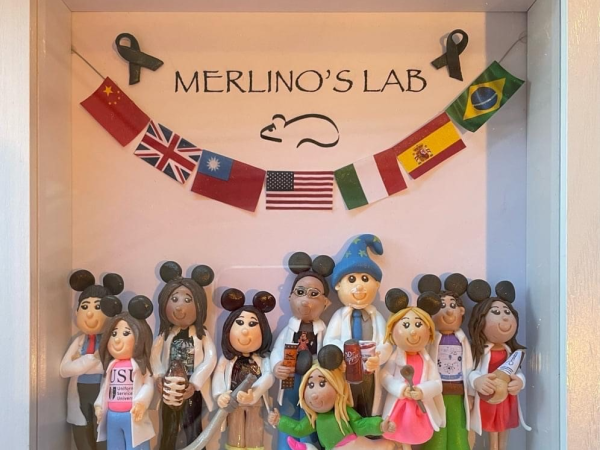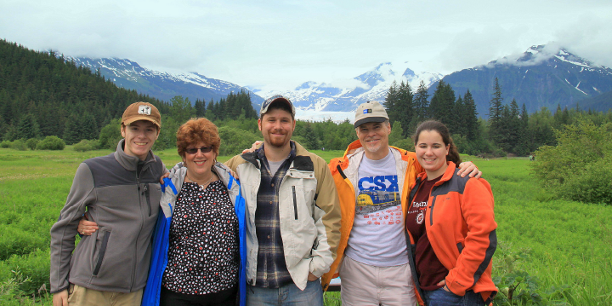Glenn Merlino, Ph.D.
Since first arriving at NCI in 1980, Glenn Merlino, Ph.D., has had a keen interest in unraveling the mechanistic underpinnings of cancer and how this knowledge could be used to improve patient care. After his graduation with a Ph.D. in biological sciences from the University of Michigan, Ann Arbor, in 1980, he became a postdoctoral fellow in the lab of Ira Pastan, M.D., who Merlino describes as the quintessential intramural researcher.
Because of Pastan’s interest in many different fields of cancer, Merlino was able to contribute to a variety of areas of research in the lab, but his first focus was on establishing in vitro transcription systems. However, it was his groundbreaking postdoctoral work showing that the EGFR receptor gene was a proto-oncogene that drew him into the study of receptor tyrosine kinases. By the 1990s, developing transgenic mouse models to mimic human cancers became a major biological advance, so with Pastan’s encouragement, Merlino became a young independent investigator with a primary focus on using mouse models to study cancer initiation and progression.
Merlino’s lab has had a predominant focus on cutaneous malignant melanoma for several reasons. Melanoma is an extremely aggressive, often fatal disease that had proven to be largely resistant to therapeutic approaches until recently. With the advent of immunotherapy, however, in combination with other treatments, there is now hope for up to 50% of newly diagnosed patients. However, much work remains to be done.
His lab has recently developed a melanoma mouse model to use in preclinical studies to uncover mechanisms associated with drug-resistant residual metastatic disease, and novel approaches to treating it. As his research evolved, Merlino also designed experiments to understand why a sunburn from exposure to ultraviolet light during childhood could be a critical risk factor for melanoma later in life.
Eventually, Merlino became Chief of the Laboratory of Cell Regulation and Carcinogenesis in 2004 and then merged with two other labs in 2006 to form the Laboratory of Cancer Biology and Genetics (LCBG), where he served as Co-Chief with Stu Yuspa, M.D., until 2014. During this period, he also served as a CCR Deputy Director. He has served as CCR’s Scientific Director for Basic Research since 2015 and as a CCR Acting Co-Director since 2024 with an unwavering dedication to the mission of the NCI and NIH, and has left a lasting legacy.
Merlino has also served as the NIH Ombudsman for Animal Welfare, a Chair of an NCI Equity and Inclusion Working Group, and a member of the CCR Science Board. He has been an Executive Editor of Pigment Cell and Melanoma Research, a Chair of the Scientific Advisory Board for the Melanoma Research Foundation (MRF), and also served on the Editorial Board of Cancer Research. He was elected an AAAS fellow in 2016 and received a Lifetime Achievement Award from the MRF in 2013.
In the Q&A that follows, Merlino discussed the work he has performed over the years, which continues today:
What have been some of the most rewarding aspects of your career?
Because I work in the intramural program, I had the freedom to pursue my most important scientific interests. As the years ticked by, one of the reasons I considered modifying my path was that I started thinking about what I truly wanted to contribute; science is fun but ultimately our responsibility is health and human well-being.
And as it turns out, our mouse models were incredibly useful for optimizing immune checkpoint blockade usage and understanding resistance. By using UV-induced melanomas as our model, we found that we generated tumors with many more neo-antigens than you have in almost any other genetically engineered mouse model. We were very lucky in that we had high neo-antigen models that were quite immunogenic. Some of our melanoma models responded very well to immune checkpoint blockade, while others did not. That allowed us to jump right into the most important part of what was going on clinically at that time.
How has the mentoring you’ve done influenced others while reflecting on your feelings about being an intramural scientist?
I have mentoring conversations with our tenure-track investigators and trainees multiple times a year. Helping to guide their path to tenure in CCR has always been a pleasure and a very rewarding experience for me. I try to convey to them my excitement about CCR as I feel so lucky that I came here. The way I envision science being conducted is exactly like what we do at CCR. I can have an inspired idea in the shower and come in and start working on it without asking anybody's permission. I mean, where else can you do that?
The well-being and successful career progression of the people who work in my lab are my first priority. But then, beyond that, the bigger picture of CCR comes into focus when you attain a leadership position and you understand things better — you're able to help more people. I felt like it's added great value to my life and my career.
You may be retiring but you’re still going to be very active in several fields of research. So what’s next?
I'm hoping to become an NIH Scientist Emeritus, and I'm going to stick around as I have a couple of people currently in my lab whose work I will continue to follow with great interest. I certainly would like to be intellectually involved with their work, as well as the outstanding science being performed by the PIs in LCBG, however best possible.
My other pursuit in retirement is a completely different area of research. I went to graduate school with Dr. Shelley Berger, and she and I were, oddly, always interested in ant societies. She now heads up the University of Pennsylvania’s Epigenetics Institute and has, among many other things, established several ant model systems. Shelley has been uniquely successful in learning a lot about the mechanisms by which social ants behave and adapt. I plan to get more involved in her work because that’s something I've always wanted to do. I'm actually excited that I may be able to contribute to two completely different areas of scientific enterprise, which to me is amazing!
Dr. Glenn Merlino will be retiring from CCR on June 30, 2024.

